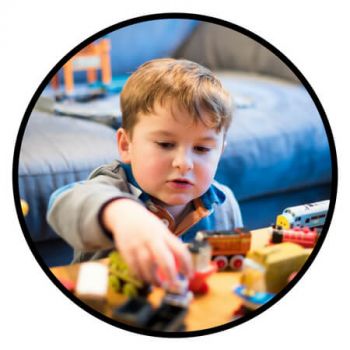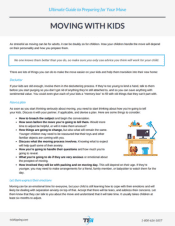Kids have little to no control over a move, and almost no say in the decisions being made, but it has a huge impact on their lives. Sometimes it means switching schools, saying goodbye to friends, and starting all over somewhere new. This is a daunting task at any age. The good news is that helping kids cope with a move doesn't have to be difficult.
There are lots of things you can do to make the move easier on everyone involved, and help them transition into their new home.
Follow these steps for an easy transition:
|
Jump to: |
1. Declutter
Moving is a great time to clear out old baby and kids clothing, toys, and gear that has been taking up space in your home. If your kids are old enough, involve them in the decluttering process. If they’re too young to lend a hand, be sure to talk to them before you start purging their past so you don’t get rid of anything they’re still attached to, and so you can save anything with sentimental value.
You could even give each of your kids a “memory box” to fill with old things that they can’t part with. Once you’re done sorting through their stuff, you can sell or donate the rest.
| PRO TIP: When selling your home, it’s also important to keep your kids’ items organized and out of sight. Don’t leave toys scattered in the yard or baby gates up for an open house - you want to make it as easy as possible for potential buyers or renters to get around the house and imagine their own stuff in the space. |
2. Get them ready
How your children handle the move will depend on their personality and how you prepare them for it. No one knows them better than you do, so make sure you only use advice you think will work for your child. Try these tips for helping kids cope with a move:
Have a plan
Kyle Hiscock, a realtor in Rochester, NY, believes that the easiest way to reduce stress when moving is to be prepared:
Families who wait until the last minute to begin preparing for the move end up creating unnecessary stress that can be avoided if they planned for the move in advance.
As soon as you start thinking seriously about moving, you need to start thinking about how you’re going to tell your kids. Discuss it with your partner, if applicable, and devise a plan. Here are some things to consider:
- How to broach the subject and begin the conversation.
- How soon before the move you’re going to tell them. Would more time be beneficial for saying goodbye to friends and making plans? Or will it make them anxious?
- How things are going to change, but also what will remain the same. Younger children may need to be reassured that their toys and other familiar objects are coming with you.
- Discuss what the moving process involves. Knowing what to expect will help quell some of their anxiety.
- How you’re going to handle their questions and how much you’re going to reveal.
- What you’re going to do if they are very anxious or emotional about the prospect of moving.
- How involved they will be with packing and on moving day. This will depend on their age. If they’re younger, you may need to make arrangements for a friend, family member, or babysitter to watch them for the day.
Toddlers and preschoolers
Child-care specialists and experts recommend that you give your toddler one to two months advanced notice of a move. This gives them enough time to prepare, but not enough time to overthink it and get anxious. Calmly break the news to them and then provide them with easy-to-understand details about what it will involve. There are lots of books that you can pick up for your preschooler (and older children) to help them understand and embrace the concept of moving, and prepare for the changes. Try these:
|
Ages 2 - 5
|
Ages 3 - 8
|
Ages 9 - 12
|
Let them express their emotions
Moving can be an emotional time for everyone, but your child is still learning how to cope with their emotions and will likely be dealing with separation anxiety on top of that. They’re leaving behind the familiar and in some cases, the only home they’ve ever known. Accept that there will be tears, let them be sad, and address their concerns. Let them know that they can talk to you about the move and understand that it will take time. It usually takes children at least six months to adjust.
Watch out for regression
If your child is feeling especially emotional over the move, watch out for changes in behavior and regression with things like potty training, clinginess, tantrums, eating habits, and attitude. This is natural in the face of a stressful situation. Rather than punishing them or trying to get them back to where they were immediately, accept that they have temporarily taken a step back and allow them to readjust. If they don’t begin to make progress again after a month or two, or if they’re displaying behaviors you find especially worrisome, talk with your pediatrician.
3. Minimize their moving stress

There are a number of tactics you can employ to help minimize your kids' moving stress.
Use distractions
If your children are nervous about leaving their school, teacher, and friends, keep them occupied with other activities. Distracting your kids with games and playdates with friends or family can help them encourage and maintain a positive mindset throughout the process.
Be positive
Children look to you to gauge how they should react to things. You may feel sad or stressed out about the move, but do your best to remain positive, especially around your child. Talk to them about the exciting new things they will be able to do and the positive aspects of their new home or city. Share photographs, tourism advertisements, and websites with them to give them a mental image of what their new life will look like.
Keep it routine
Routine is reassuring and sticking to a schedule can limit your kids’ stress, so it’s important to get your child back into their daily routine as soon as possible after you move to introduce some consistency back into their lives. Make setting up their room one of your top priorities and at the very least, keep their bedtime schedule. A couple of late nights are okay if they help get your kids excited about the move.
Involve them in the moving process
Since kids typically have little say in whether or not the family moves or where it’s moving to, they have almost no control over the situation, which can contribute to feelings of fear and anxiety. Involving your children in the process and allowing them to have control over small things can help them get a little of that power back. Try letting them:
- Pick their new bedroom.
- Select the color of their new bedroom.
- Pick out or approve a new piece of furniture, bedding, or other accessory for their room.
- Pack their own bag or box of important things, so they can feel reassured that these treasured items are coming with them. Make sure they don't pack these essential moving day items.
- Choose the layout of their bedroom.
- Unpack and arrange their belongings the way they want.
- Make small decisions about other rooms in the house by allowing them to choose between your final picks.
- If they are old enough, they can help research restaurants near your new home and plan take-out or dinners out for the first few days while you are getting settled.
| PRO TIP: If it’s early on and feasible to do, take them with you to open houses and viewings so they can get a preview of what’s to come. |
Maintain connections & say goodbye
One of the hardest parts of moving is saying goodbye to friends and family. To help your kids transition, do some fun things to say goodbye to their old home and neighborhood:
- If possible, take them to all their favorite spots one last time before the move, or at least the most important ones.
- Share memories of your home as a family.
You can also help them stay in touch with family and friends they may be leaving behind. Thanks to technology, it is easier than ever to keep in contact with long-distance loved ones. You can easily set up weekly phone calls or video chats, or help them participate in online games or activities that will allow them to continue to play with their friends even when they’re far away.
4. Get to know the new neighborhood

Before you move, try to take your kids to the new neighbourhood to show them around. If it’s too far to make the trip, use Google street view to give them an idea of what their new neighborhood looks like.
After you’ve settled in, try to find ways to make this new place feel like home:
- If it’s a new city, act like tourists and see the sights.
- Try to check out a few local food spots a week and make a game of finding new favorites.
- See if your local library or community center has a schedule of free events.
- Help your kids explore the house by playing games or giving them fun tasks.
- Have a welcome or housewarming party. Invite neighbors and classmates, as well as friends and family who live nearby.
- Volunteer and get involved in the community or at the school.
Don’t forget that young children are still learning how to develop their social skills. Rather than expecting that they’ll make friends on their own, take the time to talk to your child about ways they can approach and befriend other children. Reassure them that they will make friends again and sign them up for any activities that interest them, especially if it’s a while until school starts. Locate other kids their age in the neighborhood and help them introduce themselves. If possible, have them meet their teacher and show them around their new school before classes begin.
Make the first night special
You’ll probably all be exhausted at the end of moving day, and while it may be tempting to just crawl into bed and fall asleep, try to take some time to make the first night special and do something fun. It doesn’t need to be fancy - family time with takeout and a movie is enough.
Safety Tips
If your kids are going to be in the house on moving day, there are a few steps you can take to keep them safe and happy:
- Seal all boxes with tape.
- Place heavy boxes and objects on the floor.
- Don’t pile boxes too high.
- Leave a clear path through the whole house.
- Keep tools off the ground.
- Assign someone to keep an eye on them all day.
- Secure furniture and bookshelves.
- Keep drinks and snacks in a cooler.
Download our Printable GuideClick to download (PDF)
Download the complete printable Ultimate Guide to Preparing for Your Move. |
Keep Reading the Ultimate Guide to Preparing for Your MovePart 1: Budgeting for Your Move Part 7: Moving Large, Heavy, or Bulky Items |

